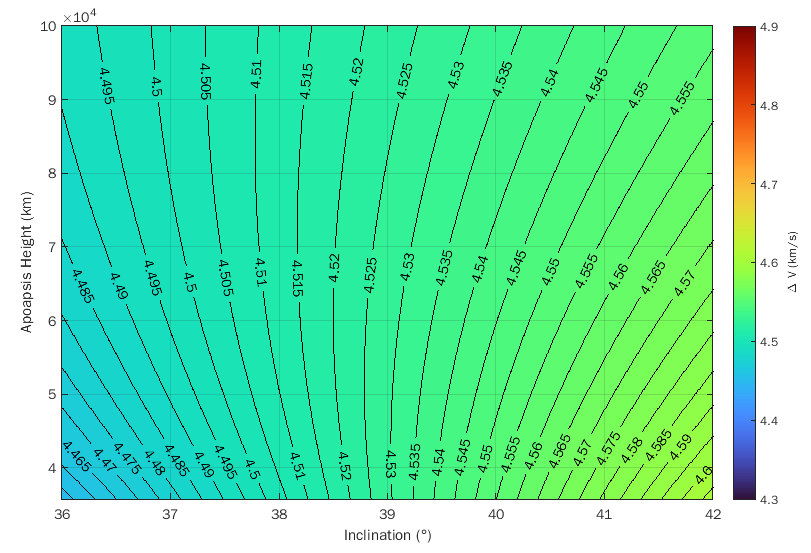In my answer to What are the benefits of supersynchronous transfer orbits? I stumbled upon an interesting outcome when considering the total $\Delta V$ cost from an inclined low altitude parking orbit to geostationary orbit using a supersynchronous transfer orbit. The maneuver profile is detailed below, requiring 3 burns:
- supersynchronous transfer orbit injection burn:
- perigee @ low parking orbit height
- apogee > geosynchronous height (> 35786 km, supersynchronous)
- no change in inclination
- $\Delta V_1 = \sqrt{\mu (\frac{2}{r_{park}}-\frac{1}{\frac{r_{park}+r_{Apo}}{2}})} - \sqrt{\frac{\mu}{r_{park}}}$
- combined plane change + perigee raising burn @ transfer orbit apogee:
- raise perigee to synchronous height (35786 km)
- change inclination to 0°
- $V_{Apo1} = \sqrt{\mu (\frac{2}{r_{Apo}}-\frac{1}{\frac{r_{park}+r_{Apo}}{2}})}, V_{Apo2} = \sqrt{\mu (\frac{2}{r_{Apo}}-\frac{1}{\frac{r_{sync}+r_{Apo}}{2}})}$
- $\Delta V_2 = \sqrt{V_{Apo1}^2 + V_{Apo2}^2 - 2V_{Apo1} \cdot V_{Apo2}\cos{i}}$ (cosine law)
- circularize @ perigee:
- $\Delta V_3 = \sqrt{\mu (\frac{2}{r_{sync}}-\frac{1}{\frac{r_{sync}+r_{Apo}}{2}})} - \sqrt{\frac{\mu}{r_{sync}}}$
The total $\Delta V$ is the sum of all 3 burns (though typically the satellite is on its own for the final 2). Plotting the total $\Delta V$ over a wide range of inclinations and transfer orbit apogees yields this (250 km parking orbit assumed):
Around ~40° it looks like the contours go vertical, indicating a sort of iso-propic line (if you will) where the total $\Delta V$ cost is independent of transfer orbit apogee (!wow). But, note that the $\Delta V$ required of the satellite (final 2 burns) decreases with increased transfer orbit apogee.
Upon closer inspection there is no proper vertical line/invariant inclination, but these 5 m/s contours show that there is a region of quasi iso-propicness around 39° inclination (5 m/s in the scheme of 4+ km/s seems pretty invariant to me):
There is no benefit for a traditional upper stage + payload combination because while the total $\Delta V$ stays the same, the distribution between launcher and payload changes by as much as ~20% for the apogee scale shown in the plots.
Consider though, a single spacecraft responsible for all of the (admittedly high) $\Delta V$. Only one transfer orbit apogee can be used per mission, of course. However, is there any reason why sitting in a ~39° inclined low Earth orbit with the ability to target geostationary orbit from any transfer orbit apogee would make sense? Even if it does make sense, are there more practical solutions?
Re: Comments, here are the 3 burns individually. The first and last don't deal with inclination and thus only depend on transfer orbit apogee (click to enlarge):


